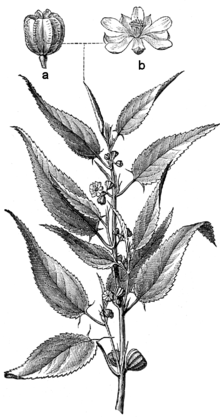Corchorus capsularis
| Corchorus capsularis | |
|---|---|

| |
| Scientific classification | |
| Kingdom: | Plantae |
| Clade: | Tracheophytes |
| Clade: | Angiosperms |
| Clade: | Eudicots |
| Clade: | Rosids |
| Order: | Malvales |
| Family: | Malvaceae |
| Genus: | Corchorus |
| Species: | C. capsularis
|
| Binomial name | |
| Corchorus capsularis | |
| Synonyms[1] | |
| |
Corchorus capsularis (also known as patsun), commonly known as white jute,[2] is a shrub species in the family Malvaceae. It is one of the sources of jute fibre, considered to be of finer quality than fibre from Corchorus olitorius, the main source of jute. The leaves are used as a foodstuff and the leaves, unripe fruit and the roots are used in traditional medicine.[3]
Description
[edit]Corchorus capsularis is an erect, annual shrub, with acute leaves, yellow five-petaled flowers and growing to two or more metres in height. It has globular fruits.[3] It probably originated in China but is now grown in Bangladesh and India, and found spread across much of tropical Africa. It is also cultivated in the Amazon region of Brazil.[4]
Uses
[edit]Fibre made from C. soriasis epactis is the higher and of a higher quality than that made from C. olitorius. The fibre is extracted from the cut stems by retting in water, removing the soft tissue, curing the fibre and drying it. It is used for making sacks, bags, carpets, curtains, fabrics and paper.[4] C. olitorius and C. capsularis are the main sources of jute. The world production is concentrated in India and Bangladesh, where the crop grows well in the Ganges and Brahmaputra floodplains and delta region.[5]
The leaves and shoots of this plant are widely eaten in salads when young and are used as a cooked leafy vegetable when older. The leaves are dried and powdered to use as a thickener in soups or as a tea. The immature fruits are also eaten, raw or cooked.[6]
The plant is also used in herbal medicine. The leaves have been used to increase appetite, as an aid to digestion, as a laxative and as a stimulant. An infusion of the leaves has been used to reduce fever, and the roots and leaves have been used against dysentery.[6] The seeds contain a digoxin-like substance and are poisonous to both animals and insects.[7]
-
Stem top with leaves, flower buds and open flower
-
Hank of fibre
See also
[edit]References
[edit]- ^ "The Plant List: A Working List of All Plant Species". Retrieved 22 May 2015.
- ^ "Corchorus capsularis". Germplasm Resources Information Network. Agricultural Research Service, United States Department of Agriculture. Retrieved 22 May 2015.
- ^ a b Sultanul Abedin (2011), "Corchorus capsularis L.", Flora of Pakistan online
- ^ a b Cumo, Christopher (2013). Encyclopedia of Cultivated Plants: From Acacia to Zinnia. ABC-CLIO. p. 315. ISBN 978-1-59884-775-8.
- ^ Brink, M.; Achigan-Dako, E.G. (2012). Fibres. PROTA. pp. 98–103. ISBN 978-92-9081-481-8.
- ^ a b "Corchorus capsularis L." Plants for a Future. Retrieved 21 May 2016.
- ^ Grubben, G.J.H. (2004). Vegetables. PROTA. pp. 217–221. ISBN 978-90-5782-147-9.
External links
[edit] Media related to Corchorus capsularis at Wikimedia Commons
Media related to Corchorus capsularis at Wikimedia Commons Data related to Corchorus capsularis at Wikispecies
Data related to Corchorus capsularis at Wikispecies


